
views
A stairway from the banks of Busuk River in east Sikkim goes to Yalle, one of the remotest villages of the state. After a two hour steep trek uphill, crossing thick plantations and natural springs, Zangbu Sherpa’s ancient wooden house emerges at the top of the hill.
Till a few years ago, Sherpa would trek uphill and downhill from the village, carrying his neighbours’ heavy load on his tiny frame and make about 100 rupees a day to feed his family. When no one in the village needed his services, he would go down the hill to lift stones at the quarry to earn a similar wage. On bad weather days, he would find no work. Income from the milk produced by his three cows was not enough to feed his family of six people.
Then in 2017, in a village meeting or the gram sabha, Sherpa, who was earning only Rs 8,000 a month, was put on the list of those who are the poorest in the village and in need of state assistance the most. Soon after, his village rozgar sahayak (or MGNREGA helper) visited his home. Within the year, Sherpa’s rickety bamboo cowshed was replaced by one with concrete pillars, tin roof and manure storing pits.
With more space for the animals, convenience in maintenance and savings from not having to fix the bamboo structure each year, Sherpa doubled the cows in two years and has space for more in the shed. His income has also almost doubled to Rs 15,000 a month.
Like in Yalle, almost all the villages scattered in the Himalayan hill state have seen the rural job guarantee scheme, or Mahatma Gandhi National Rural Employment Guarantee Act (MGNREGA), transform their lives.
After eight years of implementation, Sikkim, where three-fourths of the population lives in villages with little or no income besides agriculture, has seen a rapid fall in poverty from 31 per cent in 2004-05 to eight per cent in 2011-12. It is among the best in the country.
A big credit for this fall, state’s rural management and development department (RMDD) officials say, goes to MGNREGA. The statistic must have improved further, they say, as since 2011 the state targeted the poorest households in each hamlet and provided them income-generating assets such as animal sheds, high-value cardamom and orange plantations and water tanks.
An independent evaluation of the assets under MGNREGA in Sikkim by Tata Institute of Social Sciences in 2017 shows that many households are now self-reliant and less dependent on government programmes.
In Sherpa’s village alone, out of 65 households, 41 have received cowsheds.
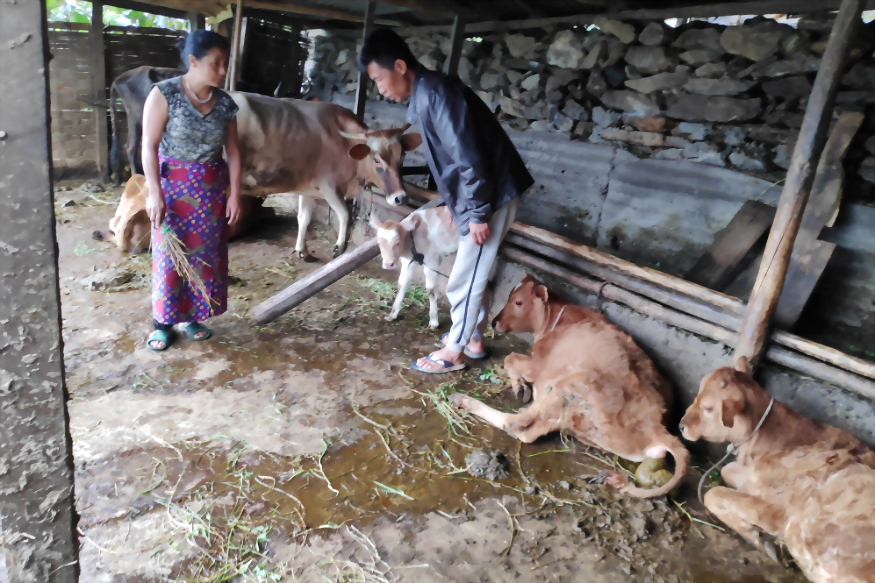
Zangbu Sherpa and his wife at the concrete cow shed which they received under MGNREGA.
Nestled on a different hill, in Tumlebong village, when the MGNREGA officials visited her house after the residents collectively decided she should receive an asset, Buddha Rani opted for a pigsty. She used to earn about Rs 20,000 a year from rearing pigs. But each time her bamboo structure would break, she would end up spending Rs 2,500 on it.
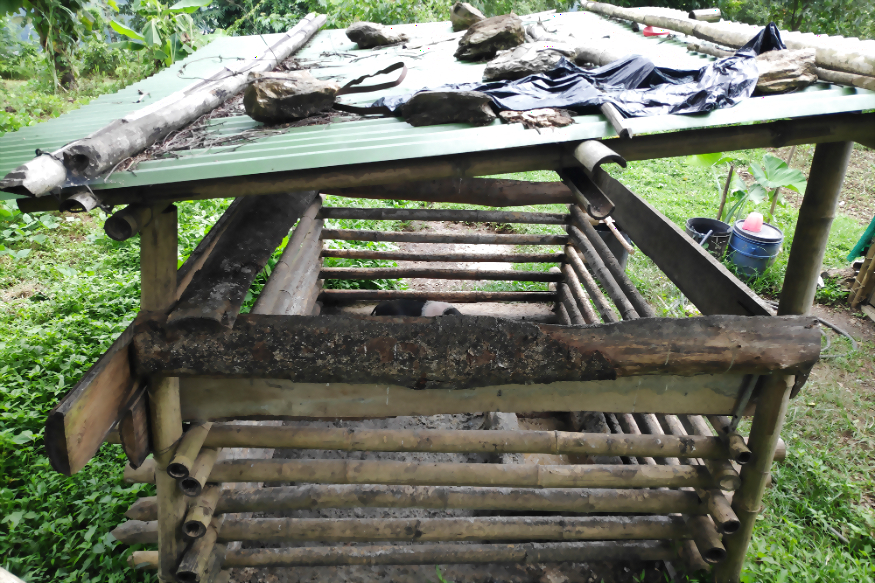
Bamboo pig sty which was replaced with a concrete structure.
Now, with a cement structure, she has seen a jump of almost Rs 10,000 annually. Her pigs are healthier, she says, and sell for a bigger price. The time she saves in maintaining the cement structure, she uses it to grow vegetables in her kitchen garden which she sells in the market for additional income.
Starting the journey of implementing the world’s largest employment scheme with no resources, Sikkim has now become a pioneer in it. It has won more than 17 awards for effective implementation of MGNREGA.
Journey from a Scratch
Three years after MGNREGA was launched in 2005 the states were struggling with unprecedented delays in payment of wages to workers, corruption and poor quality of assets created. For Sikkim, in the absence of any large industries and no low employment opportunities, MGNREGA was a window of opportunity to dent poverty.
“MGNREGA came as a safety net which prevented people from falling into poverty. The message was that if you don’t have any other livelihood, MGNREGA is there as a backup,” says Sandeep Tambe, professor at the Indian Institute of Forest Management, who initiated the scheme in Sikkim as special secretary of RMDD.
At the Centre, programmes were getting decentralised and more money was flowing in the hands of the villages. The MGNREGA gave the villages the freedom to develop based on what they need.
By 2008, the state set up administrative offices called Gram Vikas Kendras at gram panchayats with 30 trained officers with knowledge of agriculture, horticulture, animal husbandry, forestry, engineering, accounting and administrative works. One centre was set up for every five gram panchayats and their main job was to help panchayats in planning, executing and implementing MGNREGA.
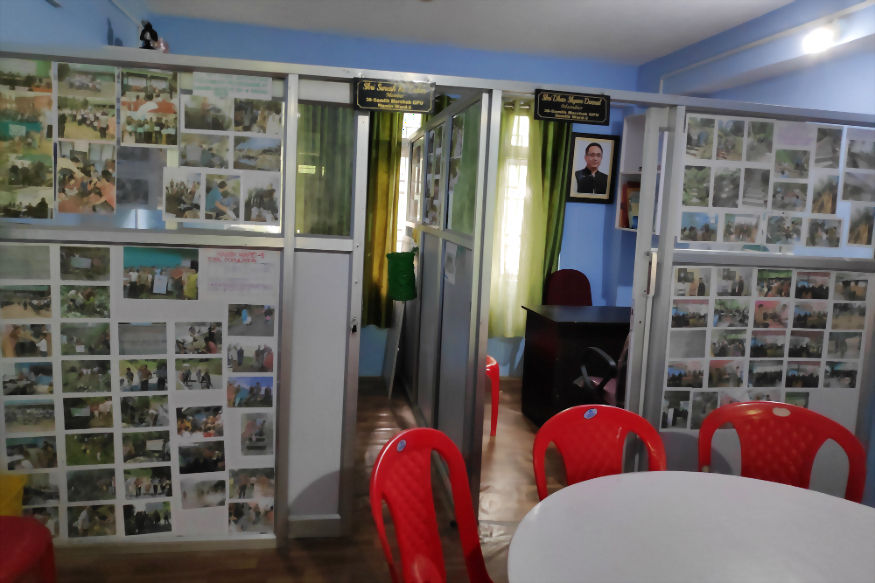
The Gram Vikas Kendra office.
By next year, all the job card holders under MGNREGA had a bank or a postal account, reducing the middlemen in wage disbursement. And by 2010, every work under the scheme was audited.
“By 2010, MGNREGA was performing beautifully in Sikkim,” says Tambe. “Corruption in wage payment was taken care of, record-keeping was decentralised and planning works were happening at the village level itself, as it is meant to be under the Act.”
The next milestone for the state was to bring down corruption in the material used for MGNREGA works. And corruption in this aspect of the scheme could only come out when government records are scrutinised and work sites are visited, explains Tambe.
Voluntary Health Association of Sikkim, a non-profit working on healthcare was selected for social auditing. Initially when the NGO started looking through the records, it could not find any wrongdoings.
“It was an area totally unknown,” says BB Rai, secretary, VHAS. With training from Society for Social Audits, Accountability and Transparency, Department of Rural Development in Telangana, the team could minutely check the loopholes in record-keeping.
In 2013-14, on an average, 16.6 misappropriations under MGNREGA were spotted in villages. This dropped to 9.6 per village by 2018-19.
A fine example of how minutely records are scrutinised in the village meetings can be seen in the recent audit report of a land development work in Kateng Pamphok village in Namthang block of south Sikkim. The audit team picked up financial deviations of even small amounts like Rs 2,428 and Rs 7,000. The matter was raised in the gram sabha and the sums were eventually recovered from the supplier.
Ten years since they began work, Rai says, the villagers now demand social audits. “They have a sense of ownership of the assets they get under MGNREGA,” he adds.
For every work happening under MGNREGA, a Worksite Material Monitoring Committee (WMMC) with one member each from the panchayat and a local civil society along with job card holders keeps a watch on the material that gets delivered to the site. In social audits in the gram sabhas expenditure vouchers are read out loud and the workers who have worked on the sites have to verify if the contents read out are correct.
“Wherever there was a difference, we could tell that there was some problem with the material,” explains Tambe. In 2013-14, irregularities worth Rs 88 lakh were detected, which was 1.74 per cent of the total MGNREGA expenditure in the state. By 2018-19, this number reduced to 0.13 per cent.
Once the social audits became more stable, the government realised that it is not only detecting corruption, but also bringing savings from the project budgets. Naming and shaming of corrupt officials started happening and the earlier practice of making fake bills to show expenditure as much as the sanctioned budget stopped.
In 2013-14, works were getting completed at 84 per cent of the sanctioned cost. This came down to 77.5 per cent by 2018-19. This 22.5 per cent of the total project funds were the state’s savings.
Assets Target Poverty
Even though administratively the scheme was working flawlessly in the state, Tambe realised that it was not creating assets which could help families enhance income. The panchayats were building public assets like pathways, drains and playgrounds. While these works are important in village connectivity, it was simply giving people a minimum wage.
The RMDD decided to give individual assets under MGNREGA. By 2010, the Centre also started allowing private works in the fields of small and marginal farmers.
But the panchayats were unwilling for this mid-course correction. Big projects are easy to plan, manage and are more visible. Also, chances of corruption are higher in bigger projects, explains Nima Tashi, senior planning coordinator, MGNREGA cell, Sikkim, who has been involved with the scheme from the beginning.
A consensus was reached and 50 per cent of MGNREGA funds for each gram panchayat were kept for individual assets. It took the state four years to bring this transition in assets.
Till then, whatever individual assets the state had promoted were mostly going to the farmers who had land. For instance, Sikkim’s weather is conducive for cardamom plantation but only those who had land could grow it. Landless farmers could not benefit from this asset.
“We were expanding the old feudal system where the landless are working in the field of the landed. We are subsidising the asset creation for the landed. Using public funds to enhance the inequity in the village was not a good idea,” says Tambe.
The state then started keeping aside the funds for the poorest 20 per cent households of a hamlet. In the gram sabhas, villagers decided the most-needy families. Preference was given to women headed households, people with disabilities and households without farmland. Analysis of each such household was done to identify which asset will benefit them the most. Plans were then made at the hamlet level on which asset is needed and these were then discussed and approved in the gram sabhas.
“These were expensive assets so there would be a lot of push and pull in the villages. Also, poorest people have the weakest voices in the village,” says Tambe.
To ensure that the assets reach the right beneficiary, the government started putting the names of the beneficiaries in the sanction orders. The social audits team later could physically verify if assets have gone to the right beneficiaries or not.
Meanwhile, MGNREGA was strapped for funds. Only 40 per cent of the total budget of a project can be spent on material under the scheme, the rest 60 per cent has to be given as wages. The RMDD was firm that it doesn’t want to dilute the quality of assets and hence, found a way around this limitation by converging with other departments.
For instance, the animal sheds, like those received by Sherpa and Rani, were in convergence with the animal husbandry department. The horticulture department gave cardamom and orange plants and agriculture department gave cement for water tanks. Wages for all these works were paid from the MGNREGA budget.
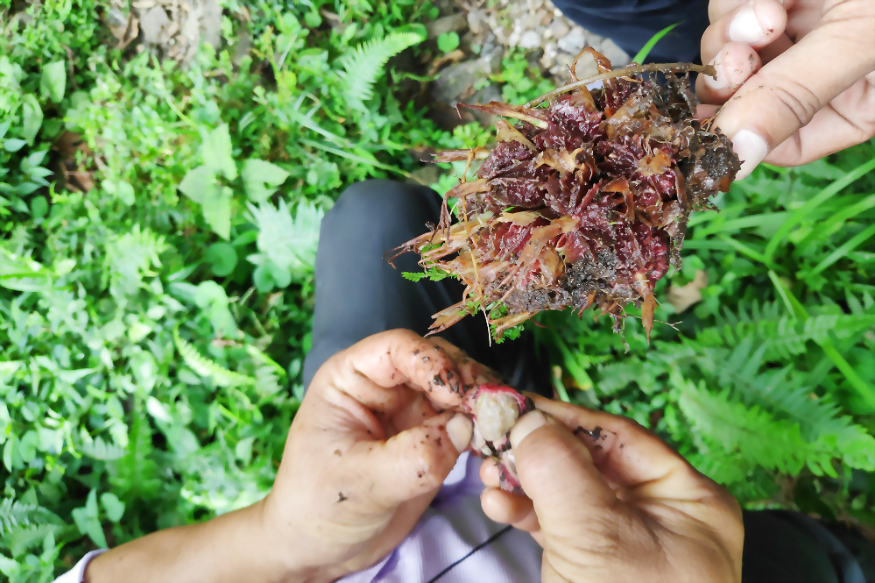
Cardamom plantation has been taken up in a big way under MGNREGA in Sikkim.
One such water tank was received by Bishnu Kumar Rai in Radong village in 2018. Rai started floriculture in 2008 because of high returns, but in winters, with limited water, his plants used to dry. He opted for a water tank under MGNREGA and has since added two more greenhouses where he grows orchids, gerbera and anthurium. From Rs 20,000 a month, his income now goes up to Rs 35,000. His tank supplies water to five other neighbourhood houses.
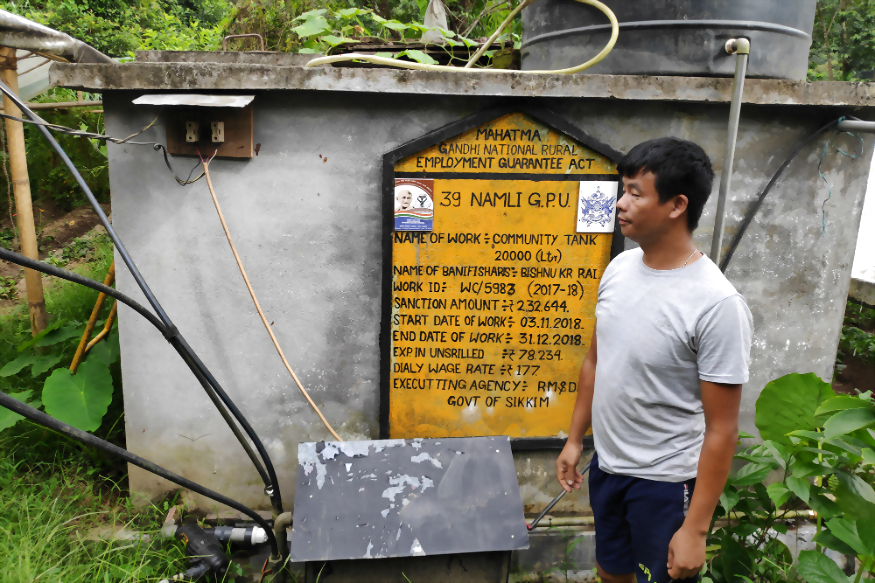
Bishnu Kumar Rai has expanded his greenhouses since he received a water tank under MGNREGA.
These assets were created in large scale from 10 per cent in 2012-13 to 69 per cent in 2018-19. Tashi explains that the assets diversified people’s livelihood and their dependency on MGNREGA reduced.
“A government programme started becoming a people’s programme. When people started getting assets, they felt it is their programme,” says Tashi.
On their visits to the villages, the RMDD teams realised that water scarcity, especially in south Sikkim, was a huge problem. Sikkim receives ample rain each year but the runoff on the hills is very fast. It prevents the water from seeping down to recharge the aquifers, because of which springs, which are the primary source of drinking water in the hills, were drying up.
The state then decided to use MGNREGA for water conservation by recharging mountain aquifers which feed the springs. For instance, in Namthang, 3,000 trenches and 150 percolation tanks were made on 30 hectare recharge area of the aquifer.
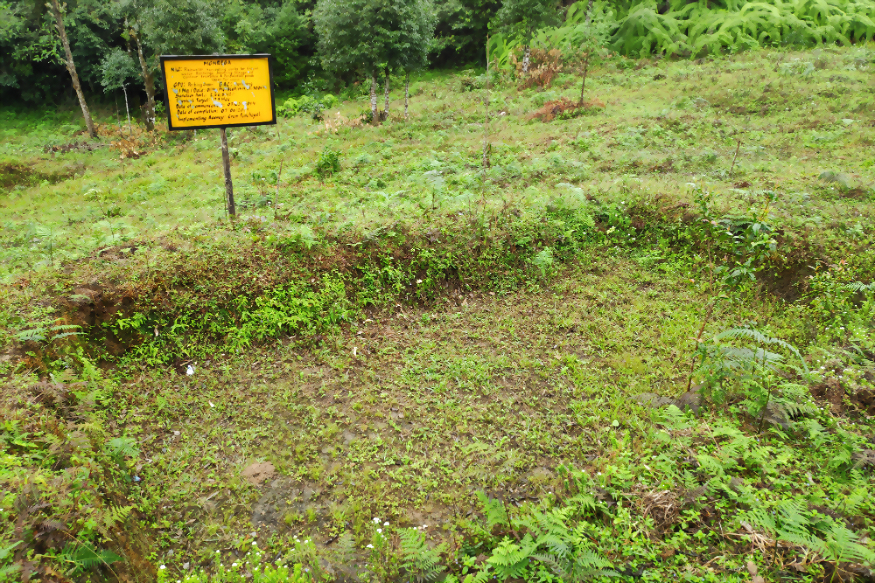
Trenches were dug under MGNREGA for storing down rain water to recharge aquifers.
Before the recharge work, about 100 households used to take water from Sethi Khola point, which was at 1,278 metres. After the recharge work, more than 300 households could use the water from it. Even in the lean season, streams as high as 1,450 metres had water and households benefiting from it have gone up from 22 to 60.
Saturation Point
While the scheme has reshaped the villages in Sikkim for good, poor recovery of misappropriated funds which the social audits highlight and no scrutiny of records of state departments which are in convergence with MGNREGA are holding the state back. Since 2017, the state has not made even a single recovery. This the social audit teams say, can loosen the faith people have on MGNREGA.
Meanwhile, over the years the state is recording fewer mandays of work under MGNREGA. For any other state, it would raise alarm bells. But for Sikkim, this is good news. Tashi explains that many villages in the state have reached saturation point. From 67 average days of employment per household in 2015-16, it has dropped to 54.2 in 2018-19. But the scheme is still seen as the one which people can use to build their own village.
“The ultimate goal of MGNREGA is not to make people dependent on it forever. The goal is to make people leave MGNREGA. So if less people are working in Sikkim under MGNREGA, it's successful,” he says.
(The author is a 2019 Promise of Commons Media fellow)












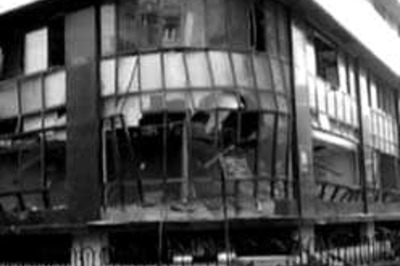


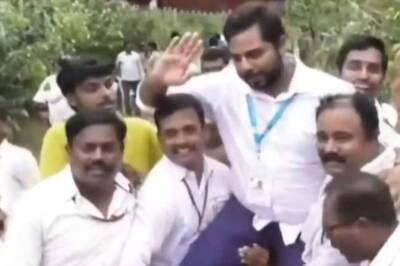
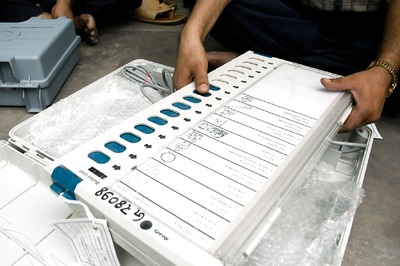


Comments
0 comment